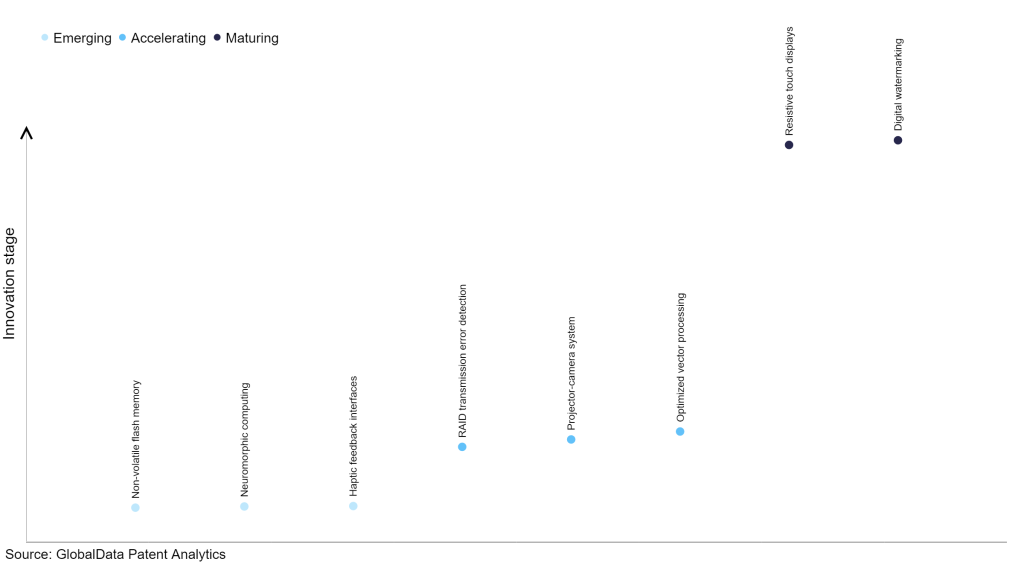The technology industry continues to be a hotbed of patent innovation. Activity is driven by applications in industries like manufacturing, healthcare, and augmented reality, where accurate spatial information is essential for various processes and applications, and growing importance of technologies such as advanced projectors, high-resolution cameras, and sophisticated algorithms for pattern analysis and reconstruction. In the last three years alone, there have been over 1.5 million patents filed and granted in the technology industry, according to GlobalData’s report on Innovation in technology: structured light-3D scanning. Buy the report here.

Access deeper industry intelligence
Experience unmatched clarity with a single platform that combines unique data, AI, and human expertise.
However, not all innovations are equal and nor do they follow a constant upward trend. Instead, their evolution takes the form of an S-shaped curve that reflects their typical lifecycle from early emergence to accelerating adoption, before finally stabilizing and reaching maturity.
Identifying where a particular innovation is on this journey, especially those that are in the emerging and accelerating stages, is essential for understanding their current level of adoption and the likely future trajectory and impact they will have.
185+ innovations will shape the technology industry
According to GlobalData’s Technology Foresights, which plots the S-curve for the technology industry using innovation intensity models built on over 1.6 million patents, there are 185+ innovation areas that will shape the future of the industry.
Within the emerging innovation stage, non-volatile flash memory, neuromorphic computing, and haptic feedback interfaces are disruptive technologies that are in the early stages of application and should be tracked closely. RAID transmission error detection, projector-camera system, and optimized vector processing are some of the accelerating innovation areas, where adoption has been steadily increasing. Among maturing innovation areas are resistive touch displays and digital watermarking, which are now well established in the industry.
Innovation S-curve for the technology industry

Structured light-3D scanning is a key innovation area in technology
Structured light 3D scanning utilizes projected patterns of structured light on an object, using the reflected light to generate a detailed 3D representation. This method enables accurate measurement of distances and captures comprehensive surface details, resulting in a precise digital model of the object.
GlobalData’s analysis also uncovers the companies at the forefront of each innovation area and assesses the potential reach and impact of their patenting activity across different applications and geographies. According to GlobalData, there are 170+ companies, spanning technology vendors, established technology companies, and up-and-coming start-ups engaged in the development and application of structured light-3D scanning.
Key players in structured light-3D scanning – a disruptive innovation in the technology industry
‘Application diversity’ measures the number of applications identified for each patent. It broadly splits companies into either ‘niche’ or ‘diversified’ innovators.
‘Geographic reach’ refers to the number of countries each patent is registered in. It reflects the breadth of geographic application intended, ranging from ‘global’ to ‘local’.
Among the companies innovating in structured light-3D scanning, Qualcomm is one of the leading patents filers. The company’s patent describes the technology pertaining to depth sensing with a device. A sample device comprises of a light projector capable of emitting light in two different patterns: one providing wide illumination in a first mode, and the other producing a structured pattern in a second mode. The device also incorporates a receiver to capture reflections of the projected light. Connected to a memory storing instructions, a processor within the device is designed to calculate initial depth data from the received reflections in the first mode, determine alternative depth data from the reflections in the second mode, and address multipath interference (MPI) by utilizing both sets of depth information. Other prominent patent filers in the space include Meta Platforms and Sony Group.
In terms of application diversity, Meta Platforms leads the pack, while Sony Group and Qualcomm stood in second and third positions, respectively. By means of geographic reach, Clarapath holds the top position, followed by Nippon Steel and Qualcomm.
Structured light-3D scanning plays a crucial role in precision measurement and 3D modeling. By projecting a known pattern onto an object and analysing its deformation, this technology enables accurate spatial reconstruction, finding applications in industries like manufacturing, healthcare, and virtual reality.
To further understand the key themes and technologies disrupting the technology industry, access GlobalData’s latest thematic research report on Technology.
Data Insights
From

The gold standard of business intelligence.
Blending expert knowledge with cutting-edge technology, GlobalData’s unrivalled proprietary data will enable you to decode what’s happening in your market. You can make better informed decisions and gain a future-proof advantage over your competitors.







